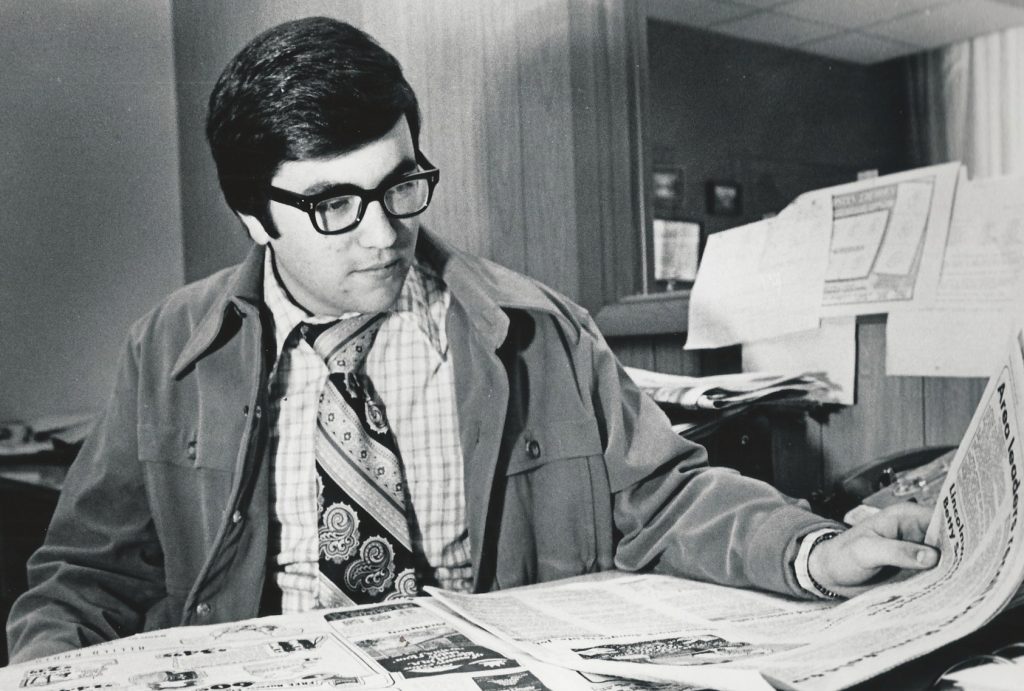Forty years ago this week I began covering the media in Chicago. Where did the time go?
On May 19, 1980 — two years out of journalism school and two days after my 24th birthday — I started at the Sun-Times, where I worked as legman for Gary Deeb, the legendary syndicated columnist who was the paper’s TV and radio critic.
First as a reporter and since 1982 as a columnist, I’ve spent every day of my working life following the ups and downs of the media business in my hometown. I couldn’t imagine a more fun or fitting career for a kid who grew up idolizing Walter Cronkite and subscribing to every trade publication around.
After stepping down from the Sun-Times, I reinvented myself in 2009 as a digital journalist, creating a daily media blog for Chicago Public Media’s Vocalo platform. It later was hosted by Time Out Chicago and Chicago Tribune Media Group, which relaunched the blog as RobertFeder.com.
Since 2017 I’ve been privileged to work for the Daily Herald, where my columns appear in print as well as online. Now more than ever I urge you to support the quality, local journalism of the Daily Herald with your digital or print subscription. (Here is the link.)
Above all, I’m most grateful to you for reading my posts and sharing your comments here and on social media. I hope you'll continue to.
As I enter a new decade on the media beat, here’s a look back at my personal top 10 stories of the last 40 years:
 Leave it to Stever (1981): When WLUP fired rising star Steve Dahl (left) for what it called "continued assaults on community standards,” the Disco Demolition bad boy suddenly lost his station identification. The news brought me my first front-page byline in the Sun-Times and began a career-defining association with the future Radio Hall of Famer. Though Dahl and I were at odds for many years, he did as much to boost my brand as anyone. People still tell me they first began reading my column because they heard him ripping me.
Leave it to Stever (1981): When WLUP fired rising star Steve Dahl (left) for what it called "continued assaults on community standards,” the Disco Demolition bad boy suddenly lost his station identification. The news brought me my first front-page byline in the Sun-Times and began a career-defining association with the future Radio Hall of Famer. Though Dahl and I were at odds for many years, he did as much to boost my brand as anyone. People still tell me they first began reading my column because they heard him ripping me.
PUSH comes to shove (1985): Sparked by the demotion of popular black news anchor Harry Porterfield, the Rev. Jesse L. Jackson led a 10-month boycott of WBBM-Channel 2 to protest the inadequate hiring and promotion of minorities. The CBS-owned station never acceded to demands for a $2 million payoff, but the covenant reached with Operation PUSH resulted in the hiring of a 27-year-old anchorman named Lester Holt. Jackson later used his clout to score contract renewals for Warner Saunders and Felicia Middlebrooks, among others.
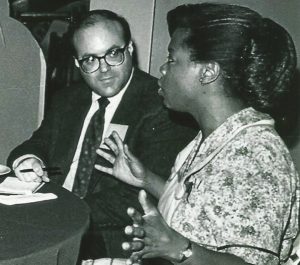 Oprah goes national (1986): Two years after an unknown Oprah Winfrey (right) burst onto the scene to salvage "A.M. Chicago" on ABC-owned WLS-Channel 7 (and run Phil Donahue out of town), she made the deal of a lifetime with brothers Roger and Michael King to launch "The Oprah Winfrey Show" into syndication. For the next 25 years the Chicago-based phenomenon was the most lucrative and successful talk show in television history. Along the way, Winfrey's ownership interest made her one of the richest self-made women in America.
Oprah goes national (1986): Two years after an unknown Oprah Winfrey (right) burst onto the scene to salvage "A.M. Chicago" on ABC-owned WLS-Channel 7 (and run Phil Donahue out of town), she made the deal of a lifetime with brothers Roger and Michael King to launch "The Oprah Winfrey Show" into syndication. For the next 25 years the Chicago-based phenomenon was the most lucrative and successful talk show in television history. Along the way, Winfrey's ownership interest made her one of the richest self-made women in America.
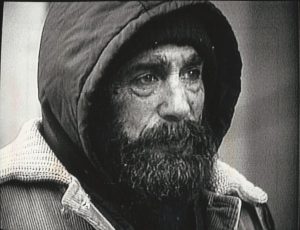 Homeless anchorman (1991): Arguably the most memorable sweeps stunt of all time saw millionaire anchorman Walter Jacobson (left) wandering the cold streets of Chicago disguised as a homeless man. "I'm miserable," he famously muttered. "I am really, really miserable." The high point came when Homeless Skippy showed up on the doorstep of anchor partner Bill Kurtis and was sent away unrecognized and empty-handed.
Homeless anchorman (1991): Arguably the most memorable sweeps stunt of all time saw millionaire anchorman Walter Jacobson (left) wandering the cold streets of Chicago disguised as a homeless man. "I'm miserable," he famously muttered. "I am really, really miserable." The high point came when Homeless Skippy showed up on the doorstep of anchor partner Bill Kurtis and was sent away unrecognized and empty-handed.
Jerry! Jerry! (1997) From studios at Chicago's NBC Tower, Jerry Springer hosted what TV Guide proclaimed "The Worst TV Show Ever." Despite a well-earned reputation as ringmaster of daytime's trashiest talk show, Springer was invited to deliver commentaries on WMAQ-Channel 5's 10 p.m. newscast. The short-lived stunt sparked a mutiny at the NBC-owned station, with top news anchors Carol Marin and Ron Magers resigning in protest, and tens of thousands of viewers bailing out in disgust. Not long after, the station execs responsible for the fiasco — general manager Lyle Banks and news director Joel Cheatwood — were sent packing.
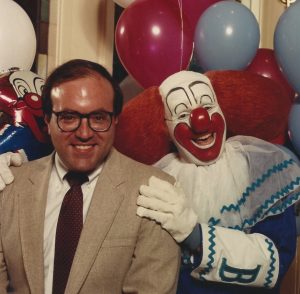 Clown goes down (2001): "Bozo's Circus," the longest-running and most beloved children's show of all time, didn't have to die. For generations it was the hottest ticket in town, once boasting a waiting list as long as 10 years. But the heartless bosses of Tribune Co. flagship WGN-Channel 9 sabotaged the iconic clown (right) by burying the show on Sunday mornings and slashing its production. When the ratings inevitably tanked, they claimed they had no choice but to pull the plug after 40 years. "Every decision is a business decision," said WGN general manager John Vitanovec.
Clown goes down (2001): "Bozo's Circus," the longest-running and most beloved children's show of all time, didn't have to die. For generations it was the hottest ticket in town, once boasting a waiting list as long as 10 years. But the heartless bosses of Tribune Co. flagship WGN-Channel 9 sabotaged the iconic clown (right) by burying the show on Sunday mornings and slashing its production. When the ratings inevitably tanked, they claimed they had no choice but to pull the plug after 40 years. "Every decision is a business decision," said WGN general manager John Vitanovec.
 Amy goes swimming (2007): Amy Jacobson (left) was on her day off as a reporter at NBC 5 when she took her two children swimming at the southwest suburban home of Craig Stebic, whose wife, Lisa, had been missing for months. That's when a photographer from rival CBS 2 shot video of the bikini-clad Jacobson over a neighbor's backyard fence. The furor over Jacobson's reporting methods (as well as CBS 2's actions) became national news, and prompted her firing after more than 10 years at NBC 5. The Mount Prospect native never worked in TV news again. Since 2010 Jacobson has been co-hosting mornings on Salem Media news/talk WIND 560-AM.
Amy goes swimming (2007): Amy Jacobson (left) was on her day off as a reporter at NBC 5 when she took her two children swimming at the southwest suburban home of Craig Stebic, whose wife, Lisa, had been missing for months. That's when a photographer from rival CBS 2 shot video of the bikini-clad Jacobson over a neighbor's backyard fence. The furor over Jacobson's reporting methods (as well as CBS 2's actions) became national news, and prompted her firing after more than 10 years at NBC 5. The Mount Prospect native never worked in TV news again. Since 2010 Jacobson has been co-hosting mornings on Salem Media news/talk WIND 560-AM.
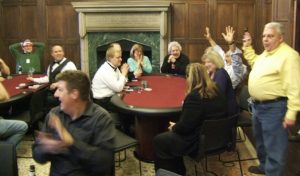 Randy’s poker party (2010): Under the ownership of billionaire Sam Zell, Tribune Co. CEO Randy Michaels (right) turned Tribune Tower into something resembling a frat house. Photos posted on my blog showed Michaels hosting a drinking, smoking and gambling party for management pals in the palatial office of Col. Robert R. McCormick. "We are in the office of the guy who ran the company from the 1920s to 1955 — it's normally a shrine," wrote the Tribune Tower building manager, who'd proudly shared the photos on Facebook. "We pretty much desecrated it with gambling, booze and cigars. Good thing we know the guy who runs the building!" In a devastating takedown by the late David Carr, The New York Times reprinted the photos from my blog as part of a front-page story on Tribune's "bankrupt culture." Two weeks later Michaels and his cronies were out.
Randy’s poker party (2010): Under the ownership of billionaire Sam Zell, Tribune Co. CEO Randy Michaels (right) turned Tribune Tower into something resembling a frat house. Photos posted on my blog showed Michaels hosting a drinking, smoking and gambling party for management pals in the palatial office of Col. Robert R. McCormick. "We are in the office of the guy who ran the company from the 1920s to 1955 — it's normally a shrine," wrote the Tribune Tower building manager, who'd proudly shared the photos on Facebook. "We pretty much desecrated it with gambling, booze and cigars. Good thing we know the guy who runs the building!" In a devastating takedown by the late David Carr, The New York Times reprinted the photos from my blog as part of a front-page story on Tribune's "bankrupt culture." Two weeks later Michaels and his cronies were out.
The Ferro papers (2011-2019): Michael Ferro, a tech entrepreneur with no background in media, declared he was out to "save journalism" when he took control of the Sun-Times. After nearly wrecking the city's No. 2 paper, he went on to seize Tribune Publishing — including the Chicago Tribune — and plunder the company he renamed tronc. His tenure at the top was cut short by reports of inappropriate sexual conduct while he was head of a Chicago investment firm. But the media mogul still had one more surprise: In what one Tribune staffer called “a final bird flip to Chicago journalism," Ferro sold all 9 million of his shares to Alden Global Capital, the New York-based slash-and-burn hedge fund known for decimating newsrooms.
 Steve Harvey’s social distancing (2017): Steve Harvey (left) went out with a bang after five years as host of his Chicago-based talk show. In an email to his NBC Tower production staff (which I posted on my blog), Harvey ordered them to keep their distance. "Do not approach me while I’m in the makeup chair unless I ask to speak with you directly," he wrote. "Do not wait in any hallway to speak to me. I hate being ambushed. Please make an appointment. I promise you I will not entertain you in the hallway, and do not attempt to walk with me." Harvey later said: “I probably should’ve handled it a little bit differently.”
Steve Harvey’s social distancing (2017): Steve Harvey (left) went out with a bang after five years as host of his Chicago-based talk show. In an email to his NBC Tower production staff (which I posted on my blog), Harvey ordered them to keep their distance. "Do not approach me while I’m in the makeup chair unless I ask to speak with you directly," he wrote. "Do not wait in any hallway to speak to me. I hate being ambushed. Please make an appointment. I promise you I will not entertain you in the hallway, and do not attempt to walk with me." Harvey later said: “I probably should’ve handled it a little bit differently.”
Friday’s comment of the day: Charlie Meyerson: It's an honor to be honored along with so many truly talented and dedicated journalists—and to connect their great work with new readers every day. I look forward to seeing you all soon.


